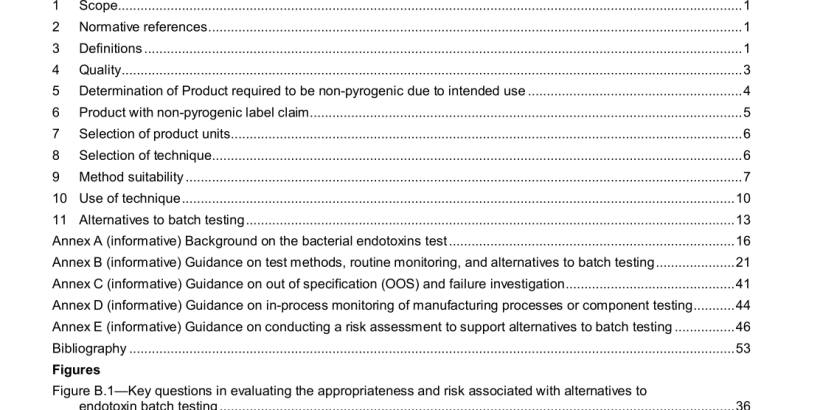ANSI AAMI ST72-2019 pdf download
ANSI AAMI ST72-2019 pdf download.Bacterial endotoxins—Test methods, routine monitoring, and alternatives to batch testing
7.3 The sampling group is generally defined as the production batch. In most cases, each batch of product must be tested using an appropriate number of samples, not more than (NMT) 10, taken randomly to represent the quality of the batch. If there is data to support a different selection basis, or alternatives to batch testing, sample selection may be based on a sampling group other than the production batch. If alternatives to batch testing are used, see Clause 11, and B.7 through B.9 and B.11 for guidance. NOTE Specification of a sampling group other than production batch should include a risk assessment to evaluate the adequacy of the criteria used to establish the group (see Annex B and Annex E).
7.4 For end-product testing, samples selected for testing should be in the finished form. This includes all factors that might affect or contribute to the levels of endotoxin (see B.7.4 for guidance). NOTE Samples utilized for endotoxin testing may be selected from routine production, products that have been rejected for other production quality issues, or surrogate samples representative of the full manufacturing process and representative endotoxin levels of product.
7.5 For end-product testing, samples may be obtained prior to (pre-) sterilization or after (post-) sterilization. Post- sterilization samples encompass all of the factors that could affect the product or the endotoxin test. When pre- sterilization samples are selected for testing, the acceptability of the samples in representing the endotoxin level on the finished product shall be justified and documented. The program for ongoing testing should consistently reflect either pre- or post-sterilization samples. Guidance is provided in B.7.5 for assessing the acceptability of pre-sterilization testing. NOTE For products that support microbial growth, the choice of pre-sterilization sampling might not be appropriate.
9.3.1.2 For photometric quantitative techniques (chromogenic and turbidimetric)
Photometric quantitative techniques require the demonstration of a linear standard curve across the range of endotoxin concentrations that will be routinely used in the analysis. At least three different endotoxin concentrations must be used to generate the standard curve. If the standard curve range is greater than two logs, additional standards should be included to bracket each log increase within the range. Each endotoxin concentration should be tested in triplicate. Linearity requires that the absolute value of the correlation coefficient |r| be ≥ 0.980 for the range of endotoxin concentrations indicated by the LAL reagent manufacturer. If a standard curve is less than two logs, it is suggested that 2-fold dilutions be performed for the standard curve. If the standard curve is greater than two logs, additional concentrations of the standard (e.g., 10-fold dilutions) should be included to bracket each log increase within the range of the standard curve. A standard curve should be no more than 4 logs, because a 5-log or greater curve can be interpreted incorrectly within the mid-range of the curve. The defined standard curve range that is used for reagent qualification is to be used during routine testing.
9.4.1 General
The BET method must be determined to be suitable with each product or product group (see B.7.3) to adequately demonstrate that the test articles do not of themselves cause inhibition, enhancement, or otherwise interfere with the accuracy and sensitivity of the test. For information on sample interference, see 9.5. The number of batches of product chosen for the suitability study shall reflect the level of control of the process and must be justified. A minimum of one batch per product or product family shall be used to demonstrate test method suitability. For photometric techniques, a valid positive product control (PPC) fulfills the requirement for test method suitability (see Table 2). NOTE 1 Development of a suitable test method might be required for products demonstrating inhibition/enhancement due to interfering factors in the sample extract. Additional information can be found in 9.5 and B.9.5. NOTE 2 A recovery efficiency study is not required. (see A.9 for discussion).
9.4.2 Gel-clot technique
9.4.2.1 Prepare solutions as listed in Table 1. The sample solution must be at a dilution less than or equal to the MVD and must not contain any detectable endotoxin in the test system used. Test each endotoxin-spiked dilution series and negative control. The geometric mean endpoint concentrations of each endotoxin-spiked dilution series can be determined using the equation listed in the preparatory testing 9.3.1 (equation 4).
